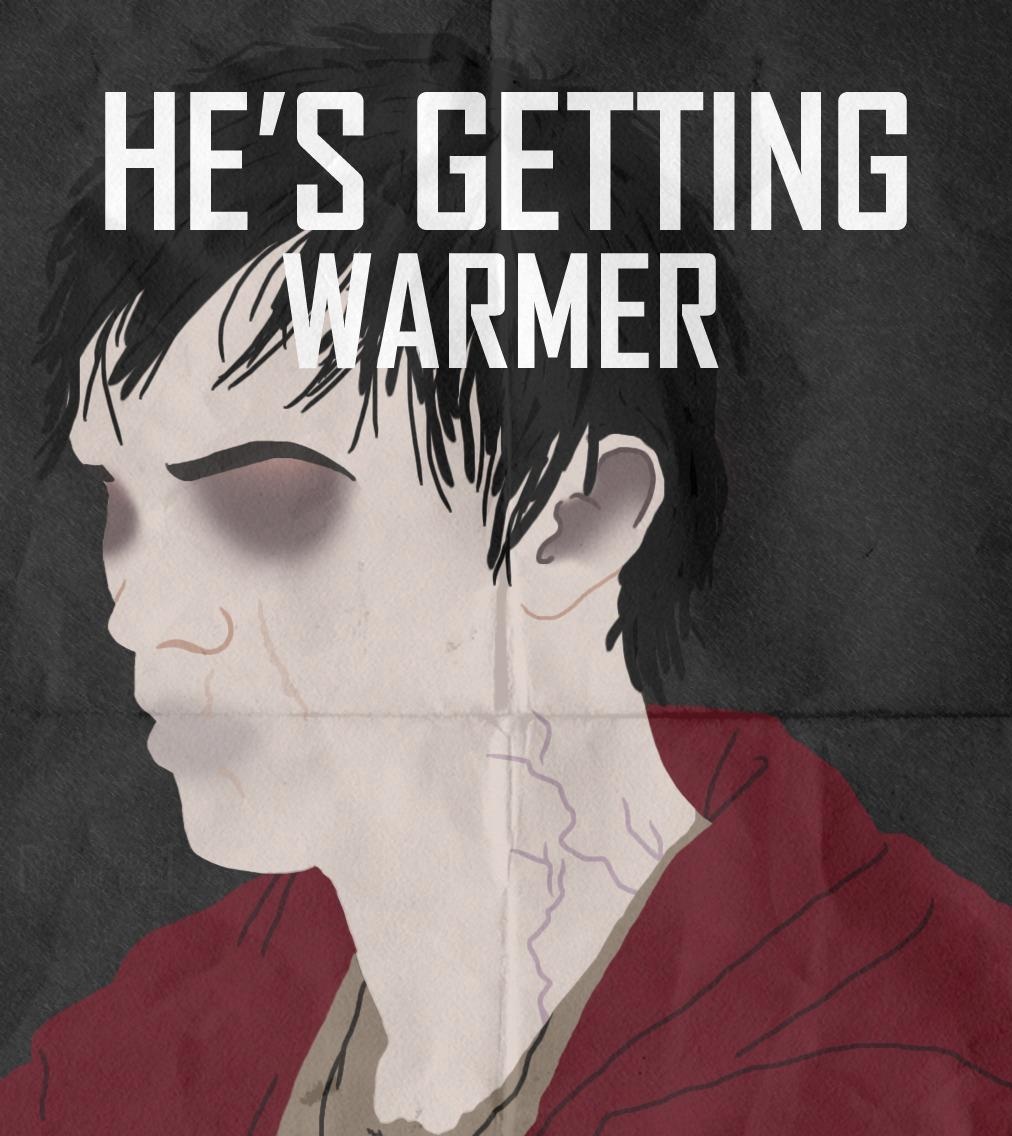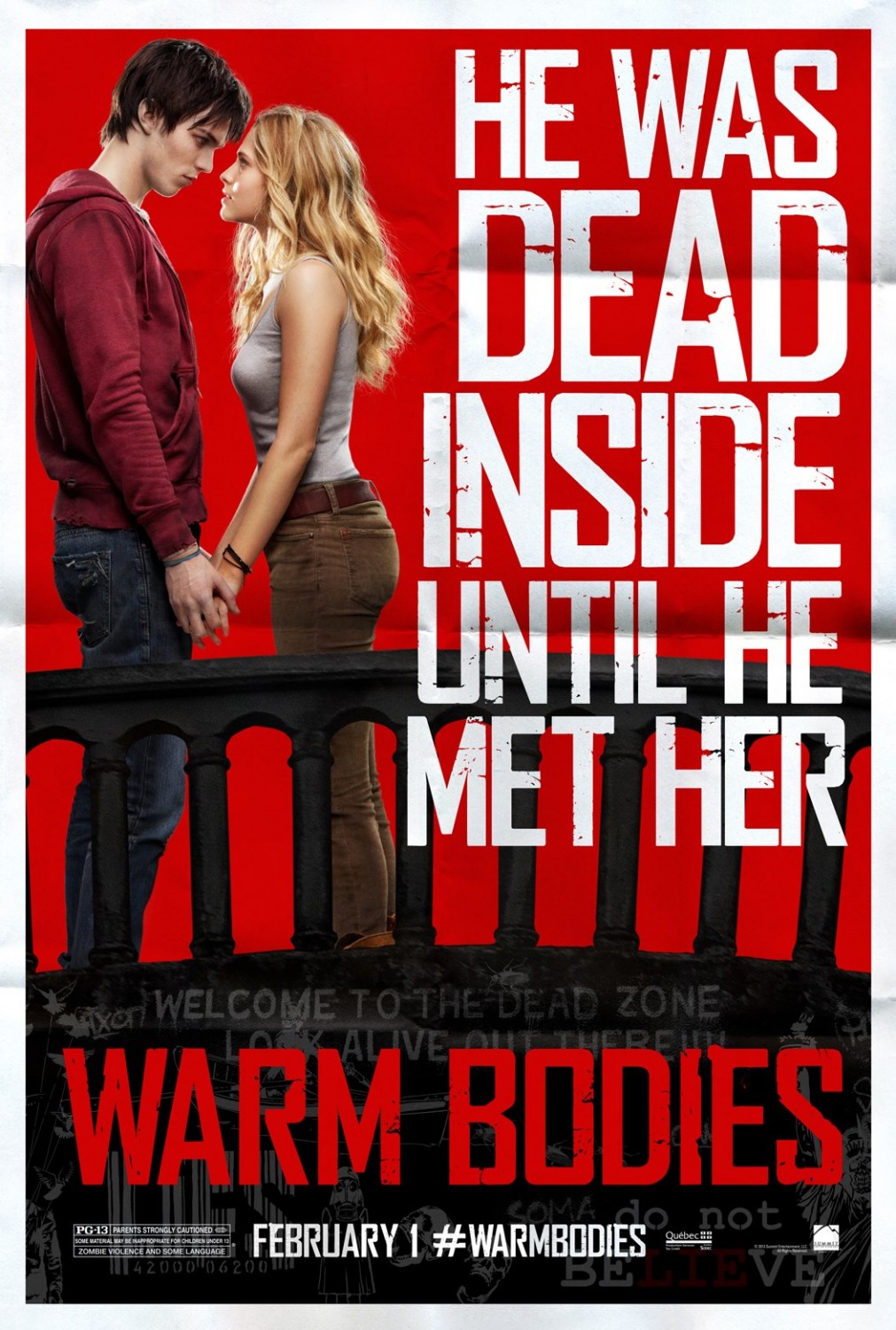
 By my own count, there are precisely three films in the underrated genre of Zombie Romantic Comedies, or RomZomComs, if you will. The first was 2004’s Shaun of the Dead, a cult classic where the zombie apocalypse was the occasion in which mid-life crisis Shaun steps up to win back his ex-girlfriend. The second is 2009’s Zombieland, where anti-social, nerdy germophobe Columbus thrives in the zombie apocalypse by teaming up with a crew of misfit survivors, one of whom quickly becomes his love interest. The third, and probably not the last, is this year’s Warm Bodies, which does the unthinkable in the zombie genre, pairing a romance between the living and the un-dead. If you’re hesitant to see the movie, don’t be–the 78% on Rotten Tomatoes is underrated in my opinion, and the usual zombie gore is kept to a PG-13 minimum. But the real reason you should go see Warm Bodies is because it’s one zombie-sized analogy to the life-giving power of one-way love, the soul-wrenching power of empathy, and the need for the world to be, well, exhumed. Spoilers Ahoy!
By my own count, there are precisely three films in the underrated genre of Zombie Romantic Comedies, or RomZomComs, if you will. The first was 2004’s Shaun of the Dead, a cult classic where the zombie apocalypse was the occasion in which mid-life crisis Shaun steps up to win back his ex-girlfriend. The second is 2009’s Zombieland, where anti-social, nerdy germophobe Columbus thrives in the zombie apocalypse by teaming up with a crew of misfit survivors, one of whom quickly becomes his love interest. The third, and probably not the last, is this year’s Warm Bodies, which does the unthinkable in the zombie genre, pairing a romance between the living and the un-dead. If you’re hesitant to see the movie, don’t be–the 78% on Rotten Tomatoes is underrated in my opinion, and the usual zombie gore is kept to a PG-13 minimum. But the real reason you should go see Warm Bodies is because it’s one zombie-sized analogy to the life-giving power of one-way love, the soul-wrenching power of empathy, and the need for the world to be, well, exhumed. Spoilers Ahoy!
R, a zombified teen protagonist with limited executive function but mostly functioning mental capacities, shuffles into town with his zombie hoard hoping to find food–and by food, of course, we mean brains. Perhaps the most interesting bit of the movie’s “zombie lore” is the rational proposed for the ubiquitous zombie love of brains. In Warm Bodies, zombies are just as existentially dead as they are physically dead: they crave emotional fulfillment as much as having their hunger satisfied. When a zombie eats a brain, it absorbs the memories and emotions of its victim, allowing the undead, unfeeling zombie to experience the victim’s emotionally potent memories. After stumbling on a pack of armed but trapped teens, R eats the brains of one unfortunate victim only to find himself immediately infatuated with the victim’s girlfriend, who’s desperately fighting off zombies at the other end of the room. Covering the girlfriend in smelly zombie goo, he helps her escape the zombie hoard, and the two grow into a friendship.
 It’s not too long into the movie before you realize that Warm Bodies is winking at Bill Shakespeare, outright recreating a Romeo and Juliet homage. Human “Julie” is rescued from a zombie attack by a zombie named “R,” and the zombies and humans quickly take on the roles of the Capulet and Montague families. Yes, there’s even a balcony scene, though you might imagine the ending of this movie is less tragic than Bill’s play. As Julie warms to her zombie rescuer, R notices changes in his undead form: his skin grows warmer, his motor skills improve, his open wounds begin to heal. Could it be that zombies get better, and they get better once they get a taste of love?
It’s not too long into the movie before you realize that Warm Bodies is winking at Bill Shakespeare, outright recreating a Romeo and Juliet homage. Human “Julie” is rescued from a zombie attack by a zombie named “R,” and the zombies and humans quickly take on the roles of the Capulet and Montague families. Yes, there’s even a balcony scene, though you might imagine the ending of this movie is less tragic than Bill’s play. As Julie warms to her zombie rescuer, R notices changes in his undead form: his skin grows warmer, his motor skills improve, his open wounds begin to heal. Could it be that zombies get better, and they get better once they get a taste of love?
I once heard a pastor describe gospel “transformation” as “the first time a grungy high-school boy has his crush reciprocated.” This high-school boy, out of nowhere, begins to care about things like hygiene, getting haircuts, wearing deodorant, trimming fingernails. His wardrobe becomes inadequate to the demands of romance, so he needs new clothes. He might even go so far as to get a part-time job to fund his romantic endeavors. In the same way, Julie’s warmth, friendship, and eventual love toward R create a transformation inside him: her external love and affection create an internal, spiritual, physical, biological, and emotional transformation. Her love, we find out, brings R back from the dead. And as their friendship blossoms, other zombies also “feel the love,” and by the end of the movie, we find the cure to the zombie illness is not medicinal but relational- external love exhumes life from within the un-dead.
“Exhume” is the great verb of the movie. R’s epiphany that he’s being healed comes when he begins to once again have dreams (after all, the un-dead can’t dream, right?). He dreams of Julie and her friends all together discussing a world which has been “exhumed,” where all dark things are unearthed, brought to light, and resolved. It’s a little cheesy, and you almost feel like they went out of the way to avoid the word “resurrection” as opposed to “exhume.” But the sentiment stands, and as the giant city wall erected to protect the humans is demolished at the movie’s end, it’s hard not to think of the dividing wall of hostility in Ephesians 2, where Jew and Greek (or the Capulet and the Montagues or the living and the un-dead!) are brought into reconciliation.
Warm Bodies is a movie where external love brings people to life, dividing walls of hostility come tumbling down, all bad things are exhumed and resolved, and eating someone’s body and blood (and brains!) engenders empathy and rescue. Among the irreligious internet-savvy counter-culture, it’s a fashionable inside joke to link the resurrection of Jesus with zombie culture (I’ll spare you their clever wit and let you google “zombie Jesus” on your own). But maybe there is something about the walking dead, the Resurrection, and the reversal of death that makes zombie culture ripe with metaphor for the Christian faith. Warm Bodies, intentionally or not, certainly makes that case.
[youtube http://www.youtube.com/watch?v=07s-cNFffDM?rel=0&w=560&h=315]

COMMENTS
3 responses to “Mockingbird at the Movies: Warm Bodies”
Leave a Reply













My wife and I saw this with our son and teenage daughter – who was dying (sorry) to see it. We were all pleasantly surprised. I really is a good movie and lead us into some great conversation.
Loved this movie.
Thanks for the insights